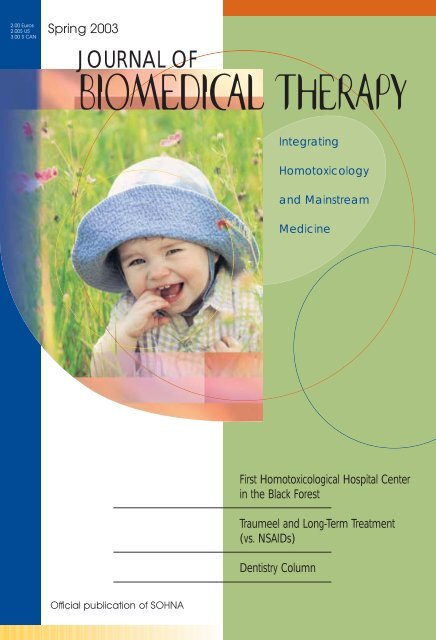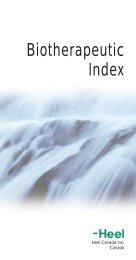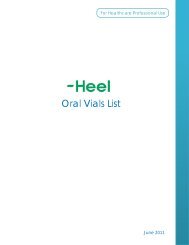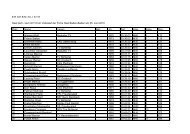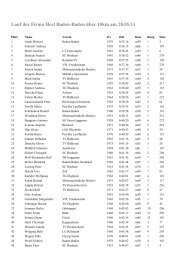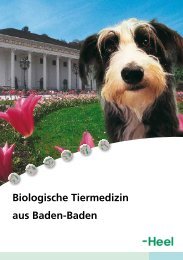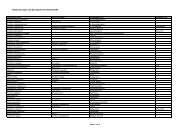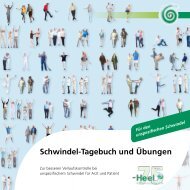Journal BT Spring 2003-18/03 - Heel
Journal BT Spring 2003-18/03 - Heel
Journal BT Spring 2003-18/03 - Heel
- TAGS
- journal
- spring
- heel
- www.heel.de
Create successful ePaper yourself
Turn your PDF publications into a flip-book with our unique Google optimized e-Paper software.
2.00 Euros<br />
2.00$ US<br />
3.00 $ CAN<br />
<strong>Spring</strong> <strong>20<strong>03</strong></strong><br />
JOURNAL OF<br />
BIOMEDICAL THERAPY<br />
Official publication of SOHNA<br />
Integrating<br />
First Homotoxicological Hospital Center<br />
in the Black Forest<br />
Traumeel and Long-Term Treatment<br />
(vs. NSAIDs)<br />
Dentistry Column<br />
Homotoxicology<br />
and Mainstream<br />
Medicine
Viburcol ® / Baby Pure ®<br />
Proven to be as effective as<br />
paracetamol* for the treatment<br />
of acute feverish infections in a<br />
multicenter, prospective cohort<br />
study with a total of 767 patients1 .<br />
ONE unique remedy to treat:<br />
Composition:<br />
• Flu<br />
• Hyperactivity<br />
• Irritability<br />
• Minor infections (with or without fever)<br />
• Otitis media<br />
• Restlessness (associated with sleeping problems)<br />
• Stomach cramps<br />
• Teething problems<br />
• Urinary tract infections<br />
Belladonna, Calcarea carbonica, Chamomilla, Dulcamara, Plantago<br />
major, Pulsatilla.<br />
* European brand name for acetaminophen such as Tempra ® and Tylenol ® .<br />
1 Müller-Krampe B, Gottwald R, Weiser M. Symptomatic treatment of acute feverish infections<br />
with a modern homeopathic medication. Biologische Medizin. 2002; 31: 79-85.<br />
INFANTS<br />
&CHILDREN<br />
Can be<br />
used<br />
immediately<br />
after<br />
birth…<br />
®
JOURNAL OF BIOMEDICAL THERAPY<br />
SUMMARY<br />
Homotoxicology In Brief<br />
• Hospital Center for Homotoxicology in the Black Forest . . . . . . . . . . . . . . 4<br />
Practical Protocols<br />
• Edema . . . . . . . . . . . . . . . . . . . . . . . . . . . . . . . . . . . . . . . . . . . . . . . . . . . . 6<br />
• Affections of the gall bladder . . . . . . . . . . . . . . . . . . . . . . . . . . . . . . . . . . . 6<br />
• Gastrointestinal problems . . . . . . . . . . . . . . . . . . . . . . . . . . . . . . . . . . . . . . 6<br />
Medical Abstracts<br />
• Treating spasmodic conditions with Spascupreel<br />
- Results of a prospective study . . . . . . . . . . . . . . . . . . . . . . . . . . . . . . . . . . 7<br />
Medical Summaries<br />
• Prophylaxis of labor anomalies by using<br />
antihomotoxic preparations . . . . . . . . . . . . . . . . . . . . . . . . . . . . . . . . . . . . . 10<br />
• The experience of application of the antihomotoxic<br />
preparations Lymphomyosot and Echinacea compositum<br />
in the treatment of children with infectious mononucleosis . . . . . . . . . . . . . 11<br />
In Your Practice<br />
• Using Traumeel ® systematically . . . . . . . . . . . . . . . . . . . . . . . . . . . . . . . . . . . 12<br />
Dentistry Column<br />
• Root canal . . . . . . . . . . . . . . . . . . . . . . . . . . . . . . . . . . . . . . . . . . . . . . . . . . 14<br />
• Tooth extraction . . . . . . . . . . . . . . . . . . . . . . . . . . . . . . . . . . . . . . . . . . . . . . 14<br />
• After extraction to help healing and reduce swelling . . . . . . . . . . . . . . . . . . . 14<br />
• Teething . . . . . . . . . . . . . . . . . . . . . . . . . . . . . . . . . . . . . . . . . . . . . . . . . . . . 14<br />
• Gingivitis . . . . . . . . . . . . . . . . . . . . . . . . . . . . . . . . . . . . . . . . . . . . . . . . . . . 15<br />
• Clenching, gnashing, grinding teeth . . . . . . . . . . . . . . . . . . . . . . . . . . . . . . . 15<br />
MEDICAL EDITOR/WRITER:<br />
Jo Serrentino<br />
Jo Serrentino is a biochemist, animal behaviourist with a doctorate in clinical ecology. She also teaches holistic<br />
veterinary medicine and veterinary homotoxicology.<br />
MANAGING EDITOR: Virginie Dionne-Bourassa PROOFREADING: Andy Moss,<br />
GRAPHIC DESIGN: Phaneuf Design Graphique Denise Preston, Dr. Rüdiger Schneider<br />
CIRCULATION: 13,145<br />
AGREEMENT NUMBER: 40016492 Made and printed in Canada<br />
Since this is an international publication, names and<br />
availability of the products mentioned in this journal<br />
may vary from one country to another.<br />
Please note that certain jurisdictions do not allow<br />
injectable homeopathics.<br />
RETURN ADDRESS:<br />
11025 L.H. Lafontaine<br />
Montreal, Quebec, Canada<br />
H1J 2Z4<br />
FOR PROFESSIONAL USE ONLY<br />
The information contained in this document is meant for professional use only and is not<br />
intended to diagnose any illness, nor is it intended to replace competent medical advice and<br />
practice. <strong>Heel</strong>/SOHNA or anyone connected to or participating in this publication will not<br />
accept any medical or legal responsibility for misinterpretation or misuse of the informational<br />
and educational content of the present document.<br />
The intention of the <strong>Journal</strong> of Biomedical Therapy is to inspire practitioners who wish to<br />
evolve their holistic practice. The purpose is to share information about successful protocols<br />
from orthodox and complementary practitioners. The intent of the information contained in<br />
this journal is not to “dispense recipes”, but to encourage learning about complementary therapies.<br />
It is the practitioner’s responsibility to take this information in stride and, if they so<br />
choose to apply it to their practice, to do so within the spectrum of their knowledge and experience<br />
with integrity and competence, and within the scope of their practice. We encourage<br />
our readers to share their complementary therapies, as the purpose of the <strong>Journal</strong> of<br />
Biomedical Therapy is to join together like-minded practitioners from around the globe.<br />
To reach our Medical writer Jo Serrentino,<br />
log on to our website.<br />
@If you wish to<br />
download this issue,<br />
visit our website at<br />
www.heel.ca (Canada)<br />
or<br />
www.heelusa.com (USA)
4<br />
Homotoxicology<br />
IN BRIEF<br />
The antihomotoxic<br />
therapeutic model<br />
The Schwarzwald<br />
Hospital Center for Homotoxicology<br />
IN THE BLACK FOREST<br />
The Schwarzwald Höhenklinik is located in the resort town of Höchenschwand in the higher elevations of the<br />
southern Black Forest. Höchenschwand’s beautiful setting and uniquely healthy climate make it the ideal place<br />
for a restorative stay. After only a few days, the body responds to higher altitudes and enjoys above average hours<br />
of sunshine. The result is more energy and improvement in many symptoms of illness.<br />
The Schwarzwald Höhenklinik, a private clinic and health resort, offers an<br />
ideal combination of pleasant ambiance and modern medical facilities.<br />
Homotoxicology is a modern homeopathic<br />
therapeutic model using homeopathic combination<br />
medications in addition to a variety of<br />
naturopathic treatments. Antihomotoxic therapy<br />
is based on four principles:<br />
1 Avoiding additional toxic loading<br />
2 Elimination and detoxification<br />
3 Strengthening of organ functions<br />
4 Enhancing the body’s immune<br />
functions<br />
An overview of treatments…<br />
Strengthening endogenous defenses<br />
Susceptibility to infections<br />
Progressive auto-sanguis therapy<br />
Autohemotherapy<br />
Nosodes<br />
Skin diseases (neurodermatitis)<br />
Specialized elimination and<br />
detoxification therapies<br />
Autohemotherapy<br />
Topical treatments<br />
Allergies<br />
Naturopathic testing methods<br />
Autohemotherapy<br />
Specialized antihomotoxic medications<br />
Carcinomas<br />
Specialized diagnostic methods<br />
Extensive laboratory testing<br />
Orthomolecular therapy<br />
Autohemotherapy<br />
Intravenous therapy
Höhenklinik<br />
Increasing energy and productivity<br />
Preventive medicine<br />
Applying homotoxicological<br />
perspectives to the patient’s<br />
medical history and treatment<br />
planning, basic laboratory testing,<br />
general elimination and<br />
detox strategies<br />
Revitalization cures<br />
Strengthening organ functions<br />
and immunostimulation<br />
Anti-aging strategies<br />
Extensive laboratory testing,<br />
combination medications,<br />
catalysts, nosodes, immunostimulation,<br />
suis-organ<br />
preparations and cosmetic<br />
treatments<br />
Specialized elimination and<br />
detox strategies<br />
Extensive laboratory testing<br />
for toxins and<br />
intravenous therapy<br />
Regulating physiological disorders<br />
Cardiovascular diseases<br />
Specialized antihomotoxic<br />
medications<br />
Perfusion disorders<br />
Intravenous therapy and<br />
autohemotherapy<br />
Gastrointestinal diseases<br />
Microbiological therapy and<br />
antihomotoxic medicine<br />
Disorders of the spine and joints<br />
Neurotherapy<br />
(neural therapy, injection of<br />
acupuncture points) and<br />
antihomotoxic medicine<br />
IN BRIEF<br />
Chronic fatigue and<br />
burn-out syndrome<br />
Toxin testing, hormones,<br />
vitamins, minerals,<br />
allergy testing and<br />
intravenous catalyst therapy<br />
Psychosomatic disorders<br />
Extensive review of the<br />
patient’s medical history,<br />
client-centered therapy and<br />
constitutional therapy<br />
Fitness and health<br />
A gymnasium for athletic activities, and a therapy room for medically supervised training are also available as<br />
well as a sauna, solarium, and 16 m swimming pool. Hospital chefs create tasty dishes that are both healthy and<br />
enjoyable.<br />
Feel well in your free time<br />
Whether in summer or in winter, the clinic offers a wide variety of options for both organized and individual<br />
recreation. Guided hikes, bicycle tours and an extensive network of fitness trails and events in the resort town of<br />
Höchenschwand are only a few of the possibilities for physical activity.<br />
Höchenschwand<br />
(elevation 3330 feet/1015 m)<br />
For more information: Call Herr Dr. med. Hans-Joachim Schmid at Tel.: +49-7672-488-221 or +49-7672-488-338<br />
Gesundheitspark Höchenschwand • Schwarzwald Höhenklinik, Sebastian-Kneipp-Straße 5, 79862 Höchenschwand, Germany<br />
Tel.: +49-7672-488-209, Fax: +49-7672-488-200 • info@die-gesundheitsparks.de • www.die-gesundheitsparks.de<br />
Chronic pain<br />
Neurotherapy<br />
(neural therapy, injection<br />
of acupuncture points) and<br />
antihomotoxic medicine<br />
Diseases of the urogenital tract<br />
Elimination therapy<br />
strengthening of the immune<br />
system and microbiological therapy<br />
Homotoxicology<br />
5
6<br />
Practical<br />
PROTOCOLS<br />
EDEMA<br />
The following protocol addresses general edema from injury such<br />
as sprains and from the effects of illness such as diabetes-induced<br />
lymphatic impediments, as well as post-surgical and post-trauma<br />
edema.<br />
LYMPHOMYOSOT/LYPHOSOT: 1 vial 3x/week orally for<br />
2 weeks, then 2x/week for 3-5 weeks<br />
or oral drops*: 10-15 drops 2x/day.<br />
For acute edema, the protocol can start with 1 vial 4 days in a<br />
row, then follow the above protocol.<br />
When edema subsides the protocol can be abridged, but for best<br />
results continued therapy with Lymphomyosot/Lyphosot for a<br />
period of at least 2 weeks will help expel the toxins associated<br />
with edema and facilitate subsequent tissue repair.<br />
AFFECTIONS OF THE GALL BLADDER<br />
When treating affections of the gall bladder, one of your<br />
first choices should be Chelidonium-Homaccord, a remedy<br />
which targets the gall bladder and bile ducts. It can be<br />
used as a sole remedy for digestive disturbances associated<br />
with gall bladder dysfunction or overload and should be<br />
used at the rate of 1 vial 2x/week for 3-5 weeks or 2 tablets<br />
b.i.d. for 4 weeks or oral drops*: 10-15 drops 2x/day.<br />
If stones are present, combine Chelidonium-Homaccord<br />
with Lycopodium-Injeel or Berberis-Homaccord,<br />
alternating these remedies throughout the protocol.<br />
GASTROINTESTINAL PROBLEMS<br />
IRRITABLE BOWEL SYNDROME (IBS)<br />
Irritable bowel syndrome is a common problem that is difficult to fix as it carries many contraindications to<br />
foods. In our modern and busy world it is difficult to make patients comply with lifestyle changes such as diet.<br />
Homotoxicology can help make the patient’s life a little easier by reducing to a minimum the toxins associated<br />
with flatulence and lessening the irritation of the intestinal mucosa.<br />
GENERAL PROTOCOL FOR IBS<br />
* Contains alcohol.<br />
PODOPHYLLUM COMPOSITUM: 1 vial 2x/week or oral drops*: 10-15 drops 2x/days.<br />
+<br />
MUCOSA COMPOSITUM : 1 vial or 2ml 2x/week for 5 weeks. The remedies can be taken<br />
together or on alternate days.<br />
AN ALTERNATIVE PROTOCOL (if above products are not available) INCLUDES :<br />
Lycopodium-Injeel :1 vial 2x/week + Pulsatilla-Injeel :1 vial 2x/week for 5 weeks, both remedies<br />
can taken together or on alternate days.<br />
Nux vomica-Homaccord can be<br />
added to either protocol, at the rate<br />
of 1 vial 1-2x/week or oral drops*:<br />
10-15 drops 2x/day, to help overall<br />
digestion. It should be taken on<br />
alternate days from the other remedies.
Treating spasmodic conditions with Spascupreel<br />
Results of a prospective study<br />
INTRODUCTION<br />
ABSTRACTS<br />
In the industrialized nations of the West, painful spasms or<br />
cramps in the gastrointestinal or urogenital tracts are very<br />
frequent complaints. In 1996 in the Federal Republic of<br />
Germany alone, nearly ten million prescriptions were written<br />
for drugs to treat these conditions. Painful spasms are<br />
often treated with chemical antispasmodics (either alone or in combination with analgesics), but because of their potential<br />
side effects, these remedies cannot always be recommended without reservation. For example, antispasmodics that contain<br />
scopolamine can cause cardiac arrhythmia and increase intraocular pressure. Additionally, the use of muscle relaxants affecting<br />
the central nervous system, which are generally used in treating various (usually chronic) spasms of the skeletal muscles,<br />
is contraindicated in many cases and always entails a certain degree of risk because of the sedative properties and addictive<br />
potential of these drugs. 1<br />
Low-risk homeopathic remedies , however, also produce good therapeutic results in treating spasms of the smooth muscles<br />
of hollow organs such as the stomach, intestine, bladder or uterus. 2–5 Spascupreel, manufactured by Biologische Heilmittel<br />
<strong>Heel</strong> GmbH, Baden-Baden (Germany), is a homeopathic combination remedy used in treating spasmodic conditions of<br />
various organs. All of the pharmacotherapeutic components of this preparation are produced according to the guidelines of<br />
the German Homeopathic Pharmacopoeia (HAB). Since one of the basic principles of homeopathy states that low potencies<br />
of homeopathically prepared ingredients act primarily on the physical level, 6 and because cramp-like symptoms are usually<br />
acute in character, the potency levels of the ingredients of Spascupreel are relatively low (Table 1).<br />
This paper describes the results of a prospective study of dosage, therapeutic efficacy and tolerance of Spascupreel in a large<br />
group of patients.<br />
METHODS<br />
ABSTRACT<br />
Data on the patients’ medical histories and treatments were<br />
recorded on standardized questionnaires. No criteria for<br />
inclusion or exclusion of patients were defined, since the purpose<br />
of this preparation-specific prospective study was to<br />
observe the entire range of conditions for which Spascupreel<br />
is prescribed. The dosage of Spascupreel (in tablet form), the<br />
duration of therapy and the option of implementing concomitant<br />
therapies was left to the attending physicians, who<br />
were required to record all data relevant to treatment on the<br />
Dr. Michael Weiser, Valérie Reus<br />
Reprint from BM, Vol. 29, No. 1, 2000, pp.14-17.<br />
This non-interventional prospective study gathered data on 698 patients and investigated<br />
usage indications, dosages, therapeutic efficacy and tolerance of Spascupreel,<br />
a homeopathic remedy prescribed primarily for lower urinary tract spasms, primary<br />
dysmenorrhea and uterine spasms. Spascupreel was the sole therapy administered to<br />
approximately 70% of the patients.<br />
Alleviation of symptoms was observed in 80% of the patients within two weeks of<br />
onset of therapy. Upon conclusion of therapy, the efficacy of Spascupreel was rated<br />
"very good" or "good" in 76% of all cases (including patients treated only with<br />
Spascupreel). Patient tolerance of the medication was rated "excellent" in the<br />
majority of cases.<br />
Keywords: Antihomotoxic therapy, homeopathy, prospective study,<br />
Spascupreel, spasms.<br />
questionnaires. The success of the protocols selected was<br />
assessed by the physicians in terms of two criteria:<br />
a) the point in time when improvement was first observed<br />
b) an overall assessment of the results of therapy, using the<br />
following five-point scale:<br />
"very good" = complete freedom from symptoms;<br />
"good" = obvious improvement;<br />
"satisfactory" = slight improvement;<br />
"no sucess" = symptoms remained the same; and worse.<br />
Medical<br />
7
8<br />
Medical<br />
ABSTRACTS<br />
TABLE 1<br />
The components of Spascupreel, their potencies in the preparation, and their characteristics or symptoms.<br />
Components Selected Characteristics/Symptoms<br />
Colocynthis 4X (colocynth) Painful cramping in the gastrointestinal tract, bile system or urinary tract.<br />
Nerve inflammation and neuralgia, especially in the face. Sciatica.<br />
Ammonium bromatum 4X Congestive upper respiratory inflammation.<br />
(ammonium bromide) Inflammation of the organs of elimination, including the skin.<br />
Spasms in the smooth musculature of hollow organs.<br />
Veratrum 6X (white hellebore) Neuralgias.<br />
Magnesium phosphoricum 6X Neuralgias. Painful gastrointestinal cramps.<br />
(magnesium phosphate) Menstrual cramps.<br />
Gelsemium 6X (wild jasmine) Headaches. Nervous disorders. Painful cramping.<br />
Passiflora incarnata 2X<br />
(passion flower)<br />
Painful cramping. Restlessness.<br />
Agaricus 4X (fly agaric) Excitability. Difficulty in emptying bladder and bowels.<br />
Chamomilla 3X (chamomile) Inflammation and cramps in the digestive organs or female genital organs.<br />
Severe pain.<br />
Cuprum sulfuricum 6X<br />
(copper sulfate)<br />
Spasms in smooth and striated muscles. Nocturnal paroxysmal cough.<br />
Aconitum 6X (monkshood) Extremely acute inflammatory diseases. Painful neurological disorders.<br />
RESULTS<br />
Patients and treatment<br />
A total of 83 physicians, primarily general practitioners and<br />
gynecologists, participated in this study by recording treatment<br />
data on 698 patients (74% female, with the emphasis<br />
in age distribution falling between 31 and 50 years). Chief<br />
usage indications included spasms of the urinary tract (24%),<br />
menstrual cramps (primary dysmenorrhea) (<strong>18</strong>%) and uterine<br />
spasms (16%). Duration of symptoms prior to treatment<br />
ranged from less than one week to several years. It is apparent<br />
from this distribution that both acute and chronic cases<br />
(duration of illness > two months) were observed in the context<br />
of this study (Table 2).<br />
Although the dosage of Spascupreel was determined<br />
on an individual basis, the standard dosage<br />
in most cases was one tablet three times a day (or,<br />
for acute symptoms, one tablet every fifteen minutes<br />
for a maximum of two hours). As expected, the<br />
TOLERANCE<br />
In seven cases (1%) the physicians reported undesired<br />
side effects during treatment with Spascupreel.<br />
The symptoms reported were: constipation (two<br />
cases), nausea, belching with foul odor, increased<br />
fatigue and weakness, foul-smelling perspiration<br />
and diarrhea. The experts who evaluated these cases<br />
found it unlikely that these symptoms were due to<br />
the use of Spascupreel. Presumably, the supposed<br />
side effects were caused either by the original illness<br />
or by concomitant medication. In spite of these<br />
seven documented cases of undesired effects, the<br />
physicians rated patient tolerance as "excellent" or<br />
"good" in 98% of cases.<br />
average duration of treatment with Spascupreel depended on<br />
whether the patient’s illness was acute or chronic. In acute<br />
cases, relatively short periods of treatment were the rule (less<br />
than two weeks in 64% of cases), while in chronic cases<br />
longer treatment periods predominated (more than two<br />
weeks in 76% of cases) (Table 3).<br />
A scant 32% of patients were prescribed medications in<br />
addition to Spascupreel (for example, for gynecological or<br />
urological conditions), while 26% received non-drug therapies<br />
(for example, diet, heat treatment or massage).<br />
TABLE 2<br />
Chief diagnoses for which Spascupreel is indicated;<br />
other diagnoses listed for more than 1% of patients.<br />
Diagnostic Groups Number of patients<br />
Total 698<br />
Urinary tract spasms 170<br />
Primary dysmenorrhea 123<br />
Uterine spasms 109<br />
Total other diagnoses: 296<br />
Abdominal cramps 29<br />
Colitis 15<br />
Intestinal spasms 60<br />
Gastric spasms 16<br />
Headache/migraine 29<br />
Lumbago with muscle hardening 19<br />
Myogelosis 15<br />
Spasmodic bronchitis 7<br />
Spasms of the trapezius muscles 11<br />
Complaints of different origins 95
THERAPEUTIC EFFICACY<br />
<strong>18</strong>% of the patients reported immediate<br />
improvement after taking Spascupreel,<br />
while an additional 60% reported improvement<br />
within two weeks. As expected,<br />
response time differed in acute and chronic<br />
cases. 89% of the patients with acute symptoms<br />
reported improvement within the first<br />
two weeks of treatment, while "only" 67%<br />
of the patients with chronic symptoms<br />
reported improvement during the same<br />
time period (Table 4). In three out of four<br />
cases, treatment with Spascupreel resulted in<br />
either complete freedom from symptoms or<br />
obvious improvement. No patients reported<br />
worsening of symptoms. Spascupreel therapy<br />
was effective in both acute and chronic<br />
illnesses and in all of the conditions origi-<br />
ABSTRACTS<br />
nally diagnosed (Table 5). The results of this study also showed that the success of therapy with Spascupreel was not contingent<br />
on adjuvant drug therapy, which was prescribed in 32% of cases. In individual cases, however, the underlying illness<br />
or the severity of the spasms certainly warranted concomitant drug therapy.<br />
TABLE 4<br />
Time when improvement was noted in different diagnostic groups<br />
(acute/chronic illnesses; number given is the number of patients).<br />
Diagnostic Groups Improvement of symptoms<br />
after after after after no improvement<br />
1st < 2 2–8 > 8<br />
treatment weeks weeks weeks<br />
Total (n = 339/359) 71/54 230/<strong>18</strong>4 20/69 3/16 15/36<br />
Urinary tract spasms 19/2 98/35 5/6 0/4 1/0<br />
(n = 123/47)<br />
Primary dysmenorrhea 14/37 16/35 0/6 0/5 1/9<br />
(n = 31/92)<br />
Uterine spasms (n = 66/43) 17/8 38/19 6/11 1/0 4/5<br />
Other diagnoses (n = 119/177) 21/7 78/95 9/46 2/7 9/22<br />
TABLE 5<br />
Results of therapy in different diagnostic groups (with/without concomitant therapy; listed as percentages).<br />
Diagnostic Groups Therapy results<br />
very good good satisfactory without success<br />
Total (n = 220/478) 28/30 48/46 17/15 7/9<br />
Urinary tract spasms (n = 46/124) 41/41 48/46 7/11 4/ 2<br />
Primary dysmenorrhea (n = 20/1<strong>03</strong>) 40/30 35/51 15/11 10/8<br />
Uterine spasms (n = 22/87) 32/28 54/40 14/21 0/11<br />
Other diagnoses (n = 132/164) 20/23 49/47 21/16 10/14<br />
CONCLUSION<br />
Of the symptoms physicians encounter on a daily basis,<br />
spasms in the smooth musculature of hollow organs are<br />
among the most unpleasant for patients. Such individuals<br />
always need fast relief from their severe pain. The<br />
results of this prospective study of 698 cases of treatment<br />
confirm that smooth muscle spasms do indeed respond<br />
to treatment with homeopathic remedies. Spascupreel<br />
not only provides temporary symptomatic relief but also<br />
produces an alteration in the patient’s constitution,<br />
reducing susceptibility to spasms in the long term.<br />
TABLE 3<br />
Duration of treatment with Spascupreel in different diagnostic groups<br />
(acute/chronic illnesses; number given is the number of patients).<br />
Duration of treatment Diagnostic Groups<br />
< 2 weeks 2-8 weeks > 8 weeks<br />
Total<br />
(n = 339/359)<br />
2<strong>18</strong>/87 112/158 9/114<br />
Urinary tract spasms<br />
(n = 123/47)<br />
80/5 41/25 2/17<br />
Primary dysmenorrhea<br />
(n = 31/92)<br />
26/41 4/15 1/36<br />
Uterine spasms<br />
(n = 66/43)<br />
35/<strong>18</strong> 27/ 19 4/6<br />
Other diagnoses 77/23 40/ 99 2/55<br />
(n = 119/177)<br />
References<br />
1 Ammon HPT. Arzneimittelneben und wechselwirkungen ("Drug side effects and interactions").<br />
3. Auflage. Stuttgart: WVG-Verlag. 1991.<br />
2 Frase W. Gastricumeel und Spascupreel – eine alternative Therapie in der Behandlung spastischer<br />
Gastritiden ("Gastricumeel and Spascupreel: an alternative therapy for spastic gastritis").<br />
Biol Med. 1986;15(5):225–226.<br />
3 Graf von Ingelheim F-A. Die Antihomotoxische Therapie von Erkrankungen der Leber, der<br />
Gallenwege und der Bauchspeicheldrüse ("Antihomotoxic treatment of diseases of the liver, bile<br />
ducts and pancreas"). Biol Med. 1990;19(1):4–16.<br />
4 Steckelbroeck V, Hübner F. Homöopathische Arzneimittel in der Geburtshilfe: Verkürzung der<br />
Eröffnungsphase bei rigidem Muttermund ("Homeopathic remedies in obstetrics: shortening<br />
the dilation phase in cases of rigid uterine cervix"). Biol Med. 1997;26(6):262–265.<br />
5 Steckelbroeck V, Hübner F, Klein P. Arzneimittelgabe bei rigidem Muttermund - eine vergleichende<br />
Untersuchung. Biol Med. 1999;28(2):76–80. Available in English as: Medication for<br />
women with rigid uterine cervix: a comparative examination. Biomedical Therapy. 2000;<br />
<strong>18</strong>(6):217–221.<br />
6 Misra SC. Dose, potency selection and repetition. The Homeopathic Heritage. 1992;92:211-215.<br />
For the author: Dr. Michael Weiser • Gleißlestrasse 34 • 77815 Bühl • Germany<br />
Medical<br />
9
10<br />
Medical<br />
SUMMARIES<br />
SUMMARY<br />
Prophylaxis of labor anomalies by using<br />
antihomotoxic preparations<br />
Reprint from International <strong>Journal</strong> of Biomedical Research and Therapy<br />
Vdovichenko Yu.P., Chemova A.V.<br />
Maternity hospital of Dneprovsky region, Kherson (Poland)<br />
The aim of the present work was to improve prelabor<br />
preparation and programmed delivery by<br />
application of antihomotoxic preparations.<br />
Coenzyme compositum and Viburcol/Baby Pure<br />
were used for prophylaxis of labor anomalies,<br />
which resulted in improved labor results.<br />
Viburcol/Baby Pure and Coenzyme compositum<br />
were used with 53 patients (group I) during prelabor<br />
preparation and delivery. The control group<br />
consisted of 105 women who were treated by<br />
standard preparation methods (group II).<br />
Analysis of preliminary results from women in Keywords: Coenzyme compositum,<br />
Group I, who used antihomotoxic preparations,<br />
Viburcol/Baby Pure, labor anomalies.<br />
show a considerably decreased number of labor<br />
complications in comparison with women in the<br />
control group. Problems with delivery and side reflex reactions were not noted in group I, but were observed<br />
in group II, by 10% and 20%, accordingly.<br />
A decrease in the number of urgent C-sections was noted in group I. As well, the number of cases of acute prenatal<br />
hypoxia and fetus asphyxia during delivery decreased markedly in the same group.<br />
The analgesic and anti-anxiety effects of the remedies were rated as 100% and 58% respectively in group I and<br />
as 56% and 1% in group II. Side effects were not observed in either group.<br />
The use of the antihomotoxic preparations Coenzyme compositum and Viburcol/Baby Pure for prophylaxis<br />
of labor anomalies during pre-labor preparation and delivery offers a high therapeutic effect<br />
and allows to avoid prescription of preparations that could negatively impact the fetus.<br />
Pediatricians
The aim of the present work was to investigate the clinical<br />
effectiveness of Lymphomyosot and Echinacea compositum<br />
in children with infectious mononucleosis (IM).<br />
Clinical-laboratory investigation was conducted in 39 children<br />
suffering from IM (ranging from 1 to 15 years of age).<br />
Four groups of observation were chosen:<br />
• Group No1 – 10 children treated conventionally;<br />
• Group No2 – 9 children treated with Lymphomyosot in<br />
addition to conventional care;<br />
• Group No3 – 10 children treated with Echinacea compositum<br />
in addition to conventional care;<br />
• Group No4 – 10 children treated with Lymphomyosot<br />
and Echinacea compositum in addition to<br />
conventional care.<br />
Lymphomyosot was prescribed in a dosage between 8-15<br />
drops 3 times daily, depending on the child’s age.<br />
Echinacea compositum was prescribed in a dosage of 1/2 -<br />
1 ampoule (2 ml), i.m., daily.<br />
All groups were comparable with diagnoses (combined<br />
forms), disease seriousness (medium seriousness),<br />
age and sex. Illness was diagnosed accord-<br />
ing to clinical epidemiological and laboratory<br />
data. Lymphomyosot and Echinacea compositum<br />
were prescribed starting on the first day<br />
of treatment and given until the end of the<br />
treatment (3 weeks later).<br />
The effectiveness of the therapy was evaluated by the<br />
dynamics of reduction of clinical symptoms of the disease.<br />
Application of both antihomotoxic preparations<br />
Lymphomyosot and Echinacea compositum in the treatment<br />
of children with IM led to satisfactory results faster<br />
than in the control group.<br />
Antihomotoxic preparations did not have side effects and showed good tolerance while<br />
antibiotics and especially desensitizing preparations very often led to deterioration.<br />
Based on the data, it was concluded that the application of Lymphomyosot and<br />
Echinacea compositum in the treatment of infectious mononucleosis in children<br />
was effective.<br />
SUMMARIES<br />
The experience of application of the<br />
antihomotoxic preparations Lymphomyosot<br />
and Echinacea compositum in the treatment<br />
of children with infectious mononucleosis<br />
SUMMARY<br />
Reprint from International <strong>Journal</strong> of Biomedical Research and Therapy<br />
Kramerev SA, Palatnaya LA, Shapoval VN, Golavach EV, Bol’shanova LA.<br />
Bogomolets National Medical University (Poland)<br />
Keywords: Lymphomyosot,<br />
Echinacea Compositum,<br />
infectious mononucleosis.<br />
Pediatricians, GP<br />
Medical<br />
11
12<br />
In Your<br />
PRACTICE<br />
USING TRAUMEEL ®<br />
SYSTEMICALLY<br />
by Dr. Jo Serrentino<br />
For more than four decades, Traumeel has been<br />
well known in both alternative and conventional<br />
medicine as a non-steroidal anti-inflammatory<br />
(NSAID) conceived for trauma-induced injuries.<br />
It has been tested clinically in nearly 30 studies<br />
for its anti-inflammatory effect on arthroses, bursitis,<br />
sports injuries, sprains and many other musculoskeletal<br />
conditions or injuries.<br />
Unlike most conventional NSAIDs, which can<br />
cause gastro-intestinal side effects and inhibition<br />
of platelet aggregation, Traumeel has no cytotoxic<br />
effect on endothelial cells, granulocytes, lymphocytes,<br />
or platelets. This makes Traumeel an<br />
excellent choice to use as a systemic NSAID.<br />
Hence, the advantage of using Traumeel in serious<br />
and painful conditions is that it does not cause<br />
adverse renal, hepatic, cardiovascular, gastrointestinal<br />
or Central Nervous System (CNS)<br />
side effects.<br />
Since Traumeel has been shown not to interact<br />
adversely with drugs, it can be used as the sole<br />
NSAID prescription or in conjunction with a<br />
conventional drug, if necessary. In such cases,<br />
conventional drugs can usually be reduced or discontinued<br />
when Traumeel is used systemically.<br />
Traumeel is also a useful adjuvant to help suppress<br />
the inflammatory responses of chemotherapy,<br />
or as a post-surgical analgesic when conventional<br />
drugs are contraindicated.<br />
USING TRAUMEEL AS AN ANALGESIC &<br />
ANTI-INFLAMMATORY AGENT IN<br />
LONG- OR SHORT-TERM THERAPY
TRAUMEEL ®<br />
Traumeel tablets or vials are the best choice to use<br />
as the sole NSAID or in conjunction with conventional<br />
drugs, or during outpatient procedures<br />
involving local anesthetic. As Traumeel has no<br />
adverse effects on body systems and is non-antagonistic<br />
to anesthetic or conventional drugs, it has a<br />
wide application in clinical practice. Traumeel has<br />
anti-inflammatory and analgesic properties and also<br />
stimulates circulation and granulation, activates<br />
fibroblasts, histogenic and hematogenic defenses in<br />
inflammatory processes, and promotes healing of<br />
soft tissue and callus formation in fractures.<br />
PRACTICE<br />
In a recent multi-center placebo-controlled<br />
clinical study, the oral administration<br />
of Traumeel was shown to have a<br />
significant and clinically relevant impact<br />
on chemotherapy-induced stomatitis in<br />
children. Its effect was noticeable with<br />
regards to both the manifestation and the<br />
duration of stomatitis. This study confirmed<br />
the preliminary results which were<br />
obtained in a previous pilot study.<br />
Traumeel can help reduce recovery time of injuries<br />
and procedures such as plastic surgery and dental<br />
surgery, as well as osteopathic or chiropractic<br />
procedures that may induce an inflammatory<br />
response.<br />
Traumeel’s very nature makes it a gentle therapy<br />
which can be used long-term. It is non-antagonistic<br />
to conventional medicine and procedures, and<br />
in this sense, is a comfort to both the patient and<br />
the physician.<br />
GENERAL PROTOCOL FOR SYSTEMIC ADMINISTRATION<br />
OF TRAUMEEL (as an NSAID and analgesic)<br />
TRAUMEEL: 1 tablet 3-5x/day (or p.r.n. up to 8 tablets per day *)<br />
or 1 vial 4x/week for 4 weeks.<br />
*( Please note that Traumeel tablets contain lactose; patients who are allergic or<br />
intolerant to lactose may experience a reaction.)<br />
In Your<br />
13
14<br />
Dentistry<br />
COLUMN<br />
Homeopathic complexes are applicable to dental procedures<br />
and surgery because they are gentle and scientifically<br />
proven effective alternatives to NSAID treatment without<br />
harsh chemicals. In dentistry, the frequent need for nonsteroidal<br />
anti-inflammatories (NSAIDs) and analgesics<br />
makes homeopathic complexes the ideal alternative<br />
choice. Moreover, by using non-chemical formulations the<br />
dentist can reduce irritation of certain procedures such as<br />
root canals, and provide non-chemical solutions to long-term<br />
problems like tooth clenching and grinding.<br />
THE FOLLOWING PROVIDES SUGGESTIONS OF<br />
SPECIFIC HEEL FORMULATIONS AND POSSIBLE PROTOCOLS FOR DENTAL<br />
PROCEDURES OR CONDITIONS:<br />
ROOT CANAL and/or TOOTH EXTRACTION<br />
Traumeel: to be used as an NSAID<br />
1 tablet dissolved under the tongue every 2 hours; up to 8 tablets per day<br />
or 1 vial orally 1-2x/day (hold liquid in mouth for 30 seconds,<br />
swish gently then swallow. No need to rinse) + Herpar sulphuris-Injeel<br />
p.r.n on site (if available)<br />
or Traumeel oral drops*: 10-15 drops 1 or 2x/day.<br />
TO HELP REDUCE ACUTE SWELLING, ESPECIALLY AFTER DENTAL SURGERY<br />
Viburcol/Baby Pure have been<br />
formulated especially for the symptoms<br />
associated with teething,<br />
including fever and inflammation.<br />
The easily administered<br />
monodoses are convenient for<br />
parents who can simply squeeze<br />
the contents of the plastic applicator<br />
onto their child’s gums.<br />
Effective teething relief is also<br />
available with BHI Chamomilla<br />
Complex tablets.<br />
DENTISTRY COLUMN<br />
Traumeel: 1 vial 2-3x/day for the first 3 days, or 1 tablet p.r.n. up to 8x/day.<br />
The advantage of using Traumeel as an NSAID is that it can be used in conjunction with conventional<br />
analgesics which are often necessary after certain dental procedures because of intense pain.<br />
In the presence of acute inflammation and throbbing, prescribe Belladonna-Homaccord<br />
or Belladonna-Injeel: 1 vial every half hour until the acute phase is over. Generally there is relief after<br />
the second dose.<br />
* Contains alcohol.<br />
TEETHING
GINGIVITIS<br />
Nux vomica-Homaccord can be used systemically to fight gingivitis: 8-<br />
10 drops 3x/day, or 1 vial daily for one week, then 3x/week for 3 weeks.<br />
Traumeel provides anti-inflammatory action to help soothe sore gums<br />
and stimulates circulation to improve healing time. The vials are the best<br />
choice for this purpose: 1 vial 2x/day for 10 days (hold liquid in mouth<br />
for 30 seconds, swish gently and swallow. No need to rinse).<br />
COLUMN<br />
Spascupreel (even when patients are using an occlusion plate)<br />
1 tablet in the evening after dinner and one tablet dissolved under the<br />
tongue before bed. Spascupreel will reduce jaw spasm associated with<br />
nocturnal tooth clenching. During the day, Spascupreel tablets can<br />
be taken at the rate of 3-5 tablets daily.<br />
When clenching causes headache, facial neuralgia and jaw pain, add<br />
Gelsemium-Homaccord (vials or drops). This remedy is a good choice to help relieve radiant pain often<br />
associated with spasm of the jaw due to clenching, grinding or gnashing. 1 vial in the morning<br />
for 2-4 weeks or oral drops*: 10-15 drops 1x/day.<br />
Traumeel is always a staple as an anti-inflammatory, and very helpful in cases of spasm due to tooth<br />
clenching. In this respect, Traumeel acts as an anti-inflammatory for the gums and jaw line. The impact<br />
of clenching can be so great as to cause chipping of the teeth and root pain due to constant pressure.<br />
Traumeel tablets are a good complement to an occlusion plate.<br />
* Contains alcohol.<br />
CLENCHING, GNASHING, GRINDING TEETH<br />
TRAUMEEL: One tablet 3-5x/day during acute clenching<br />
or high stress periods<br />
Dentistry<br />
15
Allergies<br />
Allergies<br />
THE POWER<br />
TO FIGHT OFF ALLERGIES...<br />
Luffeel/BHI Hayfever Nasal Spray’s efficacy in the treatment of seasonal<br />
allergic rhinitis was confirmed in a study comparing it to a nasal spray<br />
with Cromolyn Sodium. The conclusion of this study was that, for the<br />
treatment of hay fever, the homeopathic nasal spray is as efficient and<br />
well tolerated as the conventional therapy with Cromolyn Sodium. 1)<br />
Luffeel/BHI Hayfever Nasal Spray is a<br />
complete remedy which can be used for<br />
prevention; alone or in conjunction with<br />
other remedies such as Psorinoheel/<br />
Sorinoheel and Hepar compositum.<br />
1) Dr. S. Karger.- A Randomized Equivalence Trial Comparing the Efficacy<br />
and Safety of Luffa comp.-<strong>Heel</strong> Nasal Spray with Cromolyn Sodium<br />
Spray in the treatment of Seasonal Allergic Rhinitis.-Research in<br />
Complementary Medicine, June 1999.<br />
Luffeel/BHI Hayfever Nasal Spray contains Luffa<br />
operculata, Galphimia glauca, Histaminum and<br />
Sulphur. Luffeel/BHI Hayfever Nasal Spray is<br />
indicated in the treatment<br />
of allergic reactions of<br />
the respiratory system<br />
such as hay fever.<br />
®


